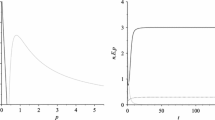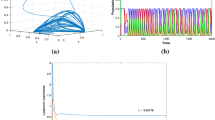Abstract
We present a dynamical model of a multi-site fishery. The fish stock is located on a discrete set of fish habitats where it is catched by the fishing fleet. We assume that fishes remain on fishing habitats while the fishing vessels can move at a fast time scale to visit the different fishing sites. We use the existence of two time scales to reduce the dimension of the model : we build an aggregated model considering the habitat fish densities and the total fishing effort. We explore a regulation procedure, which imposes an average residence time in patches. Several equilibria exist, a Fishery Free Equilibria (FFEs) as well as a Sustainable Fishery Equilibria (SFEs). We show that the dynamics depends on a threshold which is similar to a basic reproduction ratio for the fishery. When the basic reproduction ratio is less or equal to 1, one of the FFEs is globally asymptotically stable (GAS), otherwise one of the SFEs is GAS.




Similar content being viewed by others
References
Arino J (2009) Modeling and dynamics of infectious diseases, volume 11 of Contemp. Appl. Math. In: Diseases in metapopulation models. World Scientific, pp 65–123
Auger P, Bravo de la Parra R, Poggiale J-C, Sánchez E, Nguyen-Huu T (2008a) Aggregation of variables and applications to population dynamics. In: Structured population models in biology and epidemiology, volume 1936 of lecture notes in Math., Springer, Berlin, pp 209–263
Auger P, Bravodela Parra R, Poggiale J-C, Sánchez E, Sanz L (2008b) Aggregation methods in dynamical systems and applications in population and community dynamics. Phys Life Rev 5:79–105
Auger P, Lett C, Moussaoui A, Pioch S (2010) Optimal number of sites in artificial pelagic multisite fisheries. Can J Fish Aquat Sci 67:296–303
Bang-Jensen Jørgen, Gutin Gregory (2009) Digraphs springer monographs in mathematics, 2nd edn. Springer London Ltd., London (Theory, algorithms and applications) ISBN 978-1-84800-997-4. doi:10.1007/978-1-84800-998-1
Beretta E, Takeuchi Y (1988) Global stability of Lotka-Volterra diffusion models with continuous time delay. SIAM J Appl Math 48:627–651
Berman A, Plemmons RJ (1994) Nonnegative matrices in the mathematical sciences, volume 9 of Class Appl Math. Society for Industrial and Applied Mathematics (SIAM), Philadelphia, ISBN 0-89871-321-8 (Revised reprint of the 1979 original)
Bonsack JA, Johnson DL, Ambrose RF (1991) Artificial habitats for marine and freshwater fisheries. In: Ecology of artificial reef habitat and fishes. Academic Press, San Diego, pp 61–107
Chen W (1976) Applied graph theory; graphs and electrical networks. North-Holland
Clark CW (1976) Mathematical bioeconomics: the optimal management of renewable resources. Wiley-Interscience, New York (Pure and Applied Mathematics)
Clark CW (1985) Bioeconomic modelling and fisheries management. A Wiley-Interscience Publication, New York. ISBN 0-471-87394-2
Clark CW (1990) Mathematical bioeconomics. Pure and Applied Mathematics (New York) 2nd edn. John Wiley & Sons Inc., New York (The optimal management of renewable resources, with a contribution by Gordon Munro, A Wiley-Interscience Publication) ISBN 0-471-50883-7
Claudet J, Pelletier D (2004) Marine protected areas and artificial reefs: a review of the interactions between management and scientific studies. Aquat Living Resour 17(2):129–138
Coates CL (1959) Flow graph solutions of linear algebraic equations. IRE Trans Circuit Theor CT-6:170–187
de Camino-Beck T, Lewis MA, van den Driessche P (2009) A graph-theoretic method for the basic reproduction number in continuous time epidemiological models. J Math Biol 59(4):503–516. doi:10.1007/s00285-008-0240-9. ISSN 0303-6812
Dempster T, Taquet M (2004) Fish aggregation device (FAD) research: gaps in current knowledge and future directions for ecological studies. Rev Fish Biol 14:253–257
Diekmann O, Heesterbeek JAP, Metz JAJ (1990) On the definition and the computation of the basic reproduction ratio R 0 in models for infectious diseases in heterogeneous populations. J Math Biol 28(4):365–382. ISSN 0303-6812
Diekmann O, Heesterbeek JAP (2000) Mathematical epidemiology of infectious diseases. Wiley series in mathematical and computational biology. Wiley, Chichester (Model building, analysis and interpretation) ISBN 0-471-49241-8
Doob M (1984) Applications of graph theory in linear algebra. Math Mag 57(2):67–76
Fretwell SD Jr, Lucas HL (1970) On territorial behavior and other factors influencing habitat distribution in birds. I. Theoretical development. Acta Biotheorica 19:16–36
Goh BS (1977) Global stability in many-species systems. Am Nat 11:135–143
Grossman GD, Jones GP, Seaman WJ Jr (1997) Do artificial reefs increase regional fish production? A review of existing data. Fisheries 22(4):17–23
Hale JK (1980) Ordinary differential equations, 2nd edn. Krieger Publishing Company, Malabar, Florida
Hanski I (1999) Metapopulation ecology. Oxford University Press, Oxford
Hanski I, Gilpin M (1997) Metapopulation biology, ecology, genetics and evolution. Academic Press, New York
Harary F (1962) The determinant of the adjacency matrix of a graph. SIAM Rev 4:202–210. ISSN 0036-1445
Harrison GW (1979) Global stability of predator-prey interactions. J Math Biol 8:159–171
Heesterbeek JAP (2002) A brief history of R 0 and a recipe for its calculation. Acta Biotheorica 50:189–204
Hofbauer J, Sigmund K (1998) Evolutionary games and population dynamics. Cambridge University Press, Cambridge. ISBN 0-521-62365-0; 0-521-62570-X
Humphreys JE (1975) Linear algebraic groups. Springer, New York (Graduate texts in mathematics, no. 1)
Iwasa Y, Levin SA, Andreasen V (1987) Aggregation in model ecosystems. I. Perfect aggregation. Ecol Model 37:287–302
Iwasa Y, Levin SA, Andreasen V (1989) Aggregation in model ecosystems. II. Approximate aggregation. IMA J Math Appl Med Biol 6(1):1–23, ISSN 0265-0746
Jacquez JA, Simon CP (1993) Qualitative theory of compartmental systems. SIAM Rev 35(1):43–79, ISSN 0036-1445
LaSalle JP (1976) The stability of dynamical systems. Society for Industrial and Applied Mathematics, Philadelphia. In: Artstein Z (ed) With an appendix: “Limiting equations and stability of nonautonomous ordinary differential equations”, Regional conference series in applied mathematics
Luenberger DG (1979) Introduction to dynamic systems. Theory, models, and applications. Wiley, New York
Mason S, Zimmerman S (1960) Electronic circuits, signals and systems. Wiley-Interscience, New York
Mchich R, Auger P, Bravodela Parra P, Raissi N (2002) Dynamics of a fishery on two fishing zones with a fish dependent migrations: aggregation and control. Ecol Model 158(1–2):51–62
Mchich R, Charouki N, Auger P, Raissi N, Ettahiri O (2006) Optimal spatial distribution of the fishing effort in a multi-fishing zone model. Ecol Model 197:274–280
Michalski J, Poggiale J-C, Arditi R, Auger P (1997) Macroscopic dynamic effects of migrations in patchy predator-prey systems. J Theor Biol 185:459–474
Moreno G, Dagorn L, Sancho G, Itano D (2007) Fish behaviour from fishers’ knowledge: the case study of tropical tuna around drifting fish aggregating devices (DFADs). Can J Fish Aquat Sci 64(11):1517–1528
Ovaskainen O, Hanski I (2001) Spatially structured metapopulation models: global and local assessment of metapopulation capacity. Theor Popul Biol 60:281–302
Rooker JR, Dokken QR, Pattengill CV, Holt GJ (1997) Fish assemblages on artificial and natural reefs in the flower garden banks National Marine Sanctuary, USA. Coral Reefs 16:83–92
Smith HL (1995) Monotone dynamical systems. An introduction to the theory of competitive and cooperative systems. AMS, Providence
Smith VL (1968) Economics of production from natural resources. Am Econ Rev 58(3):409–431
Smith VL (1969) On models of commercial fishing. J Politic Econ 77(181–198)
Takeuchi Y, Adachi N (1980) The existence of globally stable equilibria of ecosystems of the generalized volterra type. J Math Biol 10:401–415
van den Driessche P, Watmough J (2002) reproduction numbers and sub-threshold endemic equilibria for compartmental models of disease transmission. Math Biosci 180:29–48
Volterra V (1931) Leçons sur la théorie mathématique de la lutte pour la vie, volume VII of Cahiers scientifiques. Gauthier-Villars
Author information
Authors and Affiliations
Corresponding author
Appendix
Appendix
This code computes different value linked to the existence of SFE.
We suppose to have parameters of the “vectorialized” system (2) given in the Scilab command window: namely r, K, q, p, c.
In this code we denote by Cost the real c defined by \(c = \sum\limits_{i} {c_{i} } v_{i} .,\) where v is the normalized Perron-Frobenius vector of A
This code, in a first step, orders the coordinates such that the inequalities (9) are satisfied. Then rr0 , which is \({c ({\mathcal{R}}_0 -1)}\), is computed. We have to check rr0 > 0 , a necessary condition for the existence of a SFE.
The second inequality, given by relation (18) is critSFE1 which must be positive. The value of critSFE1 , which corresponds to the criteria for the next face in the flag of faces.
function[rr0,Cost,critSFE1,critSFE2,v]=metafish(r,K,A,p,q,c) |
// notations are those of the paper |
// eigenvectors and eigenvalues of A |
[eigenvect,mat]=spec(A) |
// Searching the index of the 0 eigenvalue |
[m,k]=min(abs(diag(mat))) |
// Normalized Perron - Frobenius eigenvector |
v=eigenvect(:,k)/sum(eigenvect(:,k)) |
// ordering the coordinates |
rovera=r./(q.*v) |
[s,k]=sort(rovera)// sorting in in decreasing order |
k=k($:-1:1)// increasing order |
P=eye(A) |
P=P(:,k)// coordinate change matrix |
rovera=rovera(k) |
// reordering parameters coordinates |
rnew=P’*r;Knew=P’*K;Anew=P’*A*P;pnew=P’*p; |
qnew=P’*q;cnew=P’*c;vnew=P’*v; |
// first criterion |
rr0=sum(pnew.*qnew.*vnew.*Knew-cnew.*vnew) |
Cost=sum(cnew.*vnew) |
aoverr=(q.*v)./ r;aoverr=aoverr(k) |
vect1minus=(ones(r(2:$))-rovera(1)*aoverr(2:$)) |
SUM=sum(pnew(2:$).*qnew(2:$).*vnew(2:$).*vect1minus |
// second criterion |
critSFE1=Cost-SUM |
Knew(2:$).*vect1minus) |
vect1minus2=(ones(r(3:$))-rovera(2)*aoverr(3:$)) |
SUM2=sum(pnew(3:$).*qnew(3:$).*vnew(3:$).*vect1minus2 |
// criterion for next face |
critSFE2=Cost-SUM2 |
Knew(3:$).*vect1minus2) |
endfunction |
Rights and permissions
About this article
Cite this article
Auger, P., Moussaoui, A. & Sallet, G. Basic Reproduction Ratio for a Fishery Model in a Patchy Environment. Acta Biotheor 60, 167–188 (2012). https://doi.org/10.1007/s10441-012-9155-3
Received:
Accepted:
Published:
Issue Date:
DOI: https://doi.org/10.1007/s10441-012-9155-3




